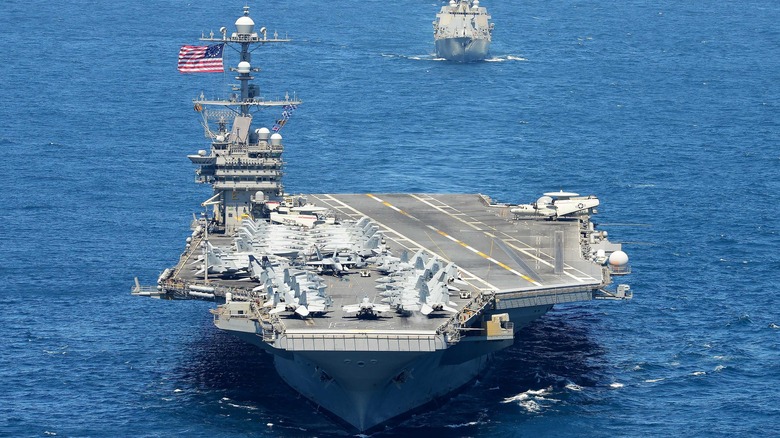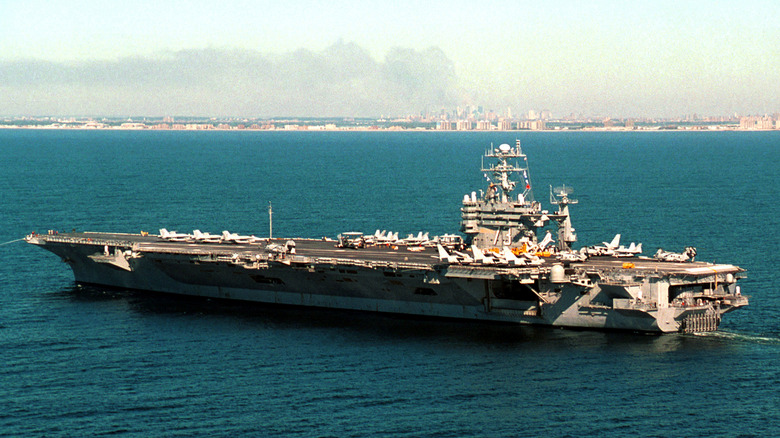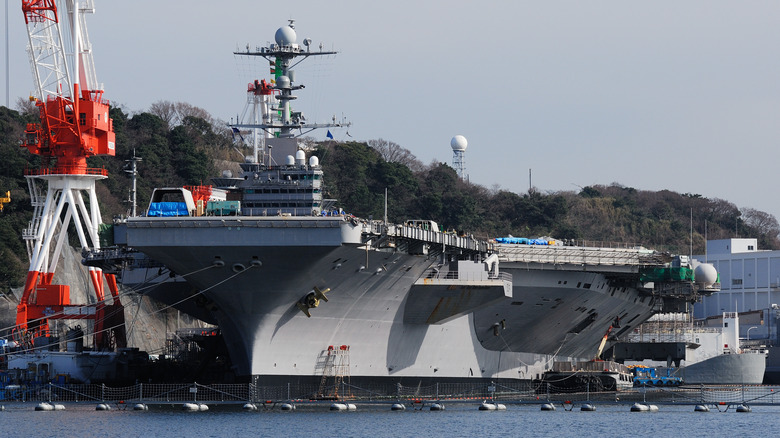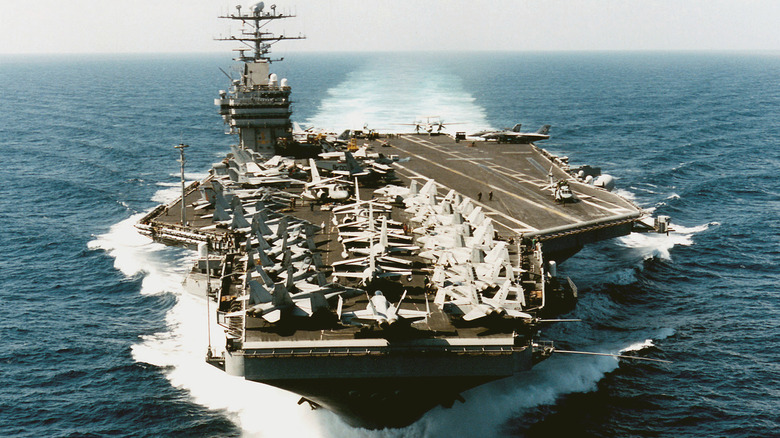What Caused The Fire On The USS George Washington (CVN 73) Aircraft Carrier?
One of the most important things every sailor knows when they're onboard a ship is that a fire is incredibly dangerous. Fires are dangerous everywhere, but when they occur on a ship like the USS George Washington (CVN-73) with all kinds of explosives, fuel, nuclear reactors, aircraft, and thousands of personnel, a fire can be catastrophic. Since 2008, the U.S. Navy has lost two ships and required maintenance of over $4 billion as a result of fires, so the Navy and U.S. government take them seriously.
On May 22, 2008, a fire broke out aboard the USS George Washington while it was off the coast of South America in the Pacific Ocean. Fortunately, no one was killed in the fire, but there were 37 sailors injured from the incident. This wasn't the first fire on a U.S. Navy vessel, nor will it be the last, but it was nonetheless serious. Once ignited, the fire spread through the USS George Washington's air-conditioning, moving throughout the ship.
Because it spread so rapidly throughout the ship, it took several hours for personnel to contain and extinguish the fire. This incident was one of the largest and most damaging fires to happen aboard a U.S. Naval vessel outside of combat in decades, and an investigation was launched to determine what caused the fire, who might have been responsible, and what could be done to prevent a similar occurrence in the future, whether it was aboard the USS George Washington, or another vessel.
Why the fire aboard the USS George Washington was so severe
The fire aboard the USS George Washington was severe, but it didn't have to be. There were several failures throughout the ship that resulted in the fire's spread. The investigation pointed the finger at a cigarette as the probable culprit, but this wasn't declared with absolute certainty. The report noted that "12 cigarette butts were found in the inlet plenum to the exhaust fan." Smoking in this area likely contributed to the fire spreading so quickly through the ventilation system.
Another significant issue that helped spread the fire was a lack of adequate training for the ship's Damage Control Training Team (DCTT). The investigation found that the fire was entirely preventable, noting that USS George Washington's Chief Engineer had previously discovered improperly stored hazardous material (HAZMAT) and notified their command team. Despite this, much of the HAZMAT either remained or was improperly stored, including 90 gallons of flammable liquid that wound up in the uptake space.
In addition to a lack of training for the DCTT, the Navy found that the ship's Damage Control Petty Officer (DCPO) and Preventive Maintenance and Material Management (3M) failed to react appropriately to the fire. This made it possible for the fire to continue to spread beyond their control, resulting in the widespread damage wrought upon the ship. Ultimately, a cascade of preventable failures resulted in a fire that injured 37 personnel and cost $70 million to repair. The Navy used these findings as lessons learned to prevent such failures in the future.
The fire onboard the USS George Washington
The fire moved rapidly through the cabling and air conditioning ducts, spreading a great deal of heat throughout the ship. Most of the injuries were the result of heat stress due to the rapid increase in heat near the flames. One sailor received first-degree burns, though there were no fatalities.
The fire spread through 80 of the carrier's 3,800 compartments and passed through multiple decks. At the time of the incident, the George Washington was en route from Chile to San Diego, but the fire sidelined the Navy's plans for the carrier, which had to dock for repairs. The ship required a great deal of repair from the fire, amounting to a cost of $70 million, and the aircraft carrier was laid up for three months to bring it back to fighting strength.
The sailors assigned to the George Washington were temporarily assigned to shore duty while repairs were underway. After it was patched up and sent on its way, the USS George Washington resumed its mission to replace the USS Kitty Hawk (CV-63) in Japan so it could be decommissioned. This was a momentous occasion because the George Washington was the first nuclear-powered aircraft carrier to port in Japan at Yokosuka Naval Base.
The aftermath of the fire on CVN-73
The fire was a serious incident that required the Navy to find whoever was responsible and ensure something like it didn't happen again. To this end, the Navy relieved both the ship's commander and its executive officer. They were technically responsible as the commanders of the USS George Washington, and the Navy isn't in the habit of letting commanders off when a ship they're responsible for is damaged to the tune of $70 million and three months of repairs.
In addition to the commander and XO, the Navy also disciplined six sailors with nonjudicial punishments. None of the sailors were discharged, and nonjudicial punishment precludes a court martial. As a result, they remained assigned to their ship and likely received reductions in pay and rank, though the details of their identities or punishment weren't made public. Other sailors were punished more severely for, as a Navy official told The Navy Times, "Their involvement in the chain of events leading to the fire."
One of the sailors was found guilty of willful dereliction of duty. Three more were found guilty of disobeying a lawful order because they were found to have hidden hazardous material aboard the ship. Two noncommissioned officers were also found guilty of negligent dereliction of duty because they were responsible for the work area where the fire initially broke out. The USS George Washington underwent months of repairs and resumed its mission. The vessel later underwent its Refueling and Complex Overhauls (RCOH) and returned to Japan in 2024.



